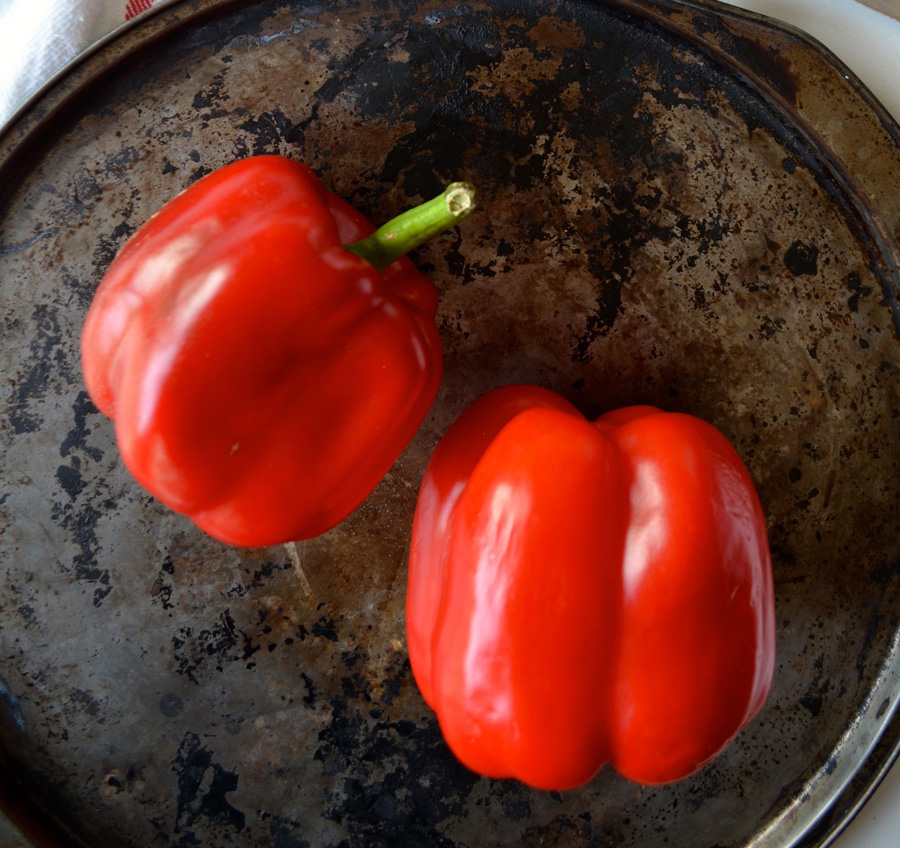Pimientos

Red peppers
Spanish conquistadors brought peppers to Spain from the New World, and from there they were introduced into Europe. Certain varieties of peppers (Capsicum annuum) have become local to some areas of Spain, like pimientos de Padrón (Padrón peppers) in Galicia, pimientos de piquillo (piquillo peppers) in Navarra or ñoras (used in the elaboration of Spanish paprika) in Murcia. Bell peppers, both green and red, are widely cultivated and used, mostly in stews or roasting them.
Pimientos de Padrón, Padrón peppers
Grown in Padrón, Galicia, they’re small, green, about 2 inches long, and are eaten mostly fried. Although most of them are mild, you will occasionally find one that is surprisingly hot.


Pimientos de piquillo, piquillo peppers
Their name comes from their shape, which is triangular and pointy. These are bright red peppers, about 3 inches long, that grow in Lodosa, Navarra (North of Spain, on the Atlantic coast). These peppers are so special that they have their own DO (Denominación de Origen), a seal that guarantees its origin and its production. In fact, piquillo peppers can be considered one of Spain’s great contributions to the culinary world (beware of imitators!) Piquillo peppers are handpicked, then roasted in wood-burning ovens, and hand skinned. They will then be canned or jarred to be sold worldwide.



Pimentón, paprika
Spanish paprika is well known and used worldwide. It is a powder that comes from dried red peppers and used to flavor and color many dishes. You can buy it mild (pimentón dulce) or hot (pimentón picante), and use one or the other according to your liking. However, the main distinction I make is between pimentón (Spanish paprika), which grows mostly in Murcia (SE coast of Spain) and pimentón de la Vera, which grows in Extremadura (West of Spain, bordering Portugal). While Spanish paprika is excellent, I tend to use more paprika of La Vera, which can now be found in America. It is believed that Christopher Columbus returned from one of his trips to America with theses peppers, and presented them to the monks at the Monastery of Yuste, in Extremadura. The monks perfected its cultivation and drying in this region, and began using it in their cooking.

Pimentón de la Vera is not a simply ground red pepper, on the contrary, its elaboration is more intensive and leads to a particular smokey flavor. The ripe red peppers are harvested by hand and brought into smokehouses. An oak fire is laid on the concrete floors of these smokehouses, and the peppers laid on grids above them. The smoke (never the flames) will dry the peppers over two weeks or so, with workers turning the peppers as needed. The smokey dry peppers will then be seeded, stemmed and ground between millstones. Their flavor is incomparable. I use pimentón de la Vera in many dishes like paella and most fish and meat stews.
Pimentón from Murcia comes from peppers that have been sun dried, or air dried (as opposed to smoked), but its uses are similar. While the introduction of the capsicum peppers in Murcia was later than in Extremadura, the region has overtaken Extremadura in terms of size of its pimentón production.


Of special interest are the ñoras and the choriceros.
Ñoras are small red peppers that grow in Murcia and are ground to make a pimentón of a very characteristic flavor.


Choriceros, grown mostly in the Pais Vasco, the Vasque Country, are used in the seasoning of chorizos and other sausages, hence their name. After harvesting, they’re hung to dry in the sun, and it is not uncommon to see them hung in many Spanish households.

Pimentón de la Vera
These are some of the pimenteon de la Vera that I use:
La Chinata Pimentón de la Vera Picante Hot
La Chinata Pimentón de la Vera Dulce Sweet
Mas Portell Pimentón de la Vera Bittersweet
Photo credits
©Natacha Sanz-Caballero, Conservas Larrinaga, Conservas de Lodosa, Conservas Aragonillo, extremaduramente

